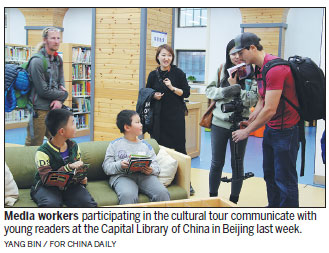Capital's diverse public cultural services celebrated
During the 2018 Silk Road Rediscovery Tour of Beijing event last week, experts said they were impressed by the friendly and diverse public cultural services in the city.
Digby Wren, an Australian professor in international relations, who has turned his research focus to the Belt and Road Initiative, said he was surprised by the breadth and depth of Beijing's cultural offerings to its residents.
Wren was one of the 11 Silk Road VIPs from nine countries - including Serbia, the United States and Egypt - who were invited to the tour, to get a glimpse into Beijing's progress in building itself into a national cultural center.
The tour included a visit to the Forbidden City Concert Hall, the National Center for the Performing Arts, the Chaoyang Cultural Museum and the Capital Library of China.
From classical music, modern drama and Peking Opera to contemporary dance, Beijing has a seemingly endless list of arts to offer.
The VIPs visited the home of the China Philharmonic Orchestra, also the major venue for premier events - the Forbidden City Concert Hall.
A highlight of the well-known international Beijing Music Festival, the renowned Broadway musical West Side Story, which became a blockbuster film, was recently staged at the hall, winning the hearts of Chinese audiences.
Amazed at the ellipsoid building, crystal-clear water pond and surrounding green space, VIPs enjoyed their short stay at the National Center for the Performing Arts.
"The visit to the national arts center was a sunny window on Beijing's evolution into a global cultural capital," Wren said.
Situated in the heart of Beijing, the NCPA provides a crucial venue for the performing arts, with its elegant performance auditoriums - featuring a concert hall, theater and art and exhibition spaces open to the public and integrated with the city - and its vision of "for people, for art and for the world".
"Our center is garnering an increasing international fan base and providing the public with a passage from their daily life to the world of opera, fiction and dreams," said a staff member.
Aside from bringing aesthetics to audiences inside its 'cultural palaces', Beijing is looking to give its residents access to arts without leaving their communities.
The VIPs toured Chaoyang Cultural Museum, a multifunctional building with a range of rooms. Squired by its curator, the foreign guests passed through a classroom where a choir of seniors from the Chaoyang Xiangheyuan area was practicing, all happy and active.
The museum holds a raft of such activities for ordinary people with dreams. For example, it has helped found a group of drummers comprised of laid-off women workers, according to the curator.
Below this classroom, there is a theater for the Peking Opera, an exhibition room for intangible cultural heritage such as terra-cotta warriors in bright colors and a display room of antiques.
Above the classroom, plays were put on by British acting group TNT Theatre and there were young dancers from the 9 Contemporary Dance Troupe in a rehearsal room.
Meanwhile, in a reading room at the Capital Library of China, a staff member showed the VIPs devices made for visually impaired readers and books with big letters for the elderly.
Beijing has also done a great job in improving the lives of disadvantaged groups, said one reader in the library.
Stepping into the children's section, Wren, together with other visitors, was touched by a scene of a pregnant woman rubbing her tummy, while telling stories to her unborn baby.
For over a century since its founding, the library has been preserving and maintaining memories of the capital city. It has created a database called "Beijing Memory", which comprises documents, research findings and photos of old Beijing.

(China Daily 11/22/2018 page10)














